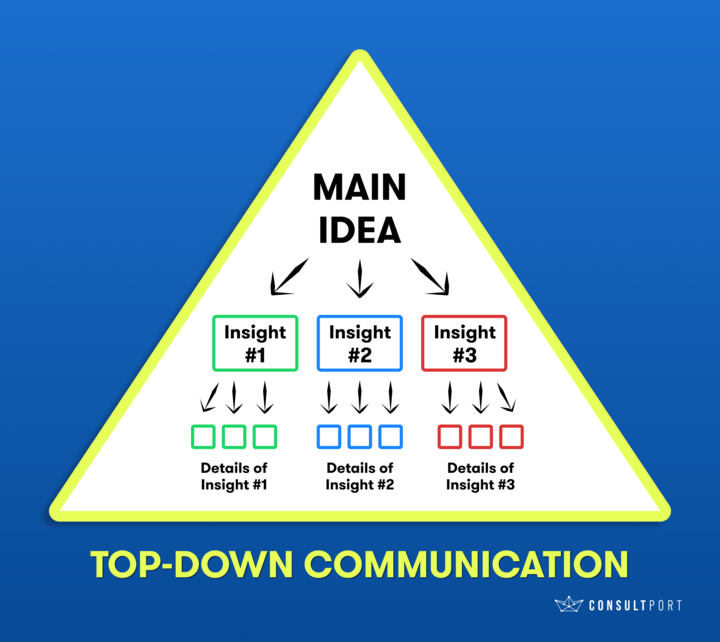How to Nail Top-Down Communication
One may think that a consultant's job revolves around data, insights, and analyses. Although it’s true, there’s one more key skill that will shape your management consulting career path—it’s your communication skills.
You should realize that communication skills in consulting mean something completely different than what it means in other industries. In hospitality, for instance, an example of good communication skills involves resolving a conflict with a customer. In consulting, however, what defines your communication skills is your ability to break down complex jargon into simple information and deliver it to the layperson as quickly and gracefully as possible.
One way to achieve this is the top-down communication method, which some professionals also call the Pyramid Principle. It’s pretty much the standard in McKinsey and some other firms, too. Well, if the top players are doing it, then maybe you should learn it as well.
What is Top-Down Communication?
The top-down communication method, also known as the Pyramid Principle, is a way of communication in which the main idea is stated first, followed by the elaboration of the key insights from that main idea, and then by getting down to the nitty-gritty of each insight.
This method could be confusing to understand without a diagram, so, let’s examine it once again with the infographic found below.
As you can see, the main idea is at the top of the pyramid. Then, on the level below are three key insights from the main idea. And then, all the insights are explained in detail further down below. If you were wondering why it’s called the Pyramid Principle, now you know.
There are many definitions of top-down communication, and some of them even includes elements that are irrelevant to communication. For instance, some websites display an organizational hierarchy chart and claim that this is what top-down communication is. However, in a consulting context, top-down communication simply means starting your discussion with the conclusion and explaining the details in the further steps.
KEY TAKEAWAYS
- The top-down communication method involves stating the conclusion first and moving on to the details later.
- It starts with the “what”, then it’s followed by the “how”, and ultimately, it ends with “how exactly”.
- C-suite executives are very busy, so any communication that is targeted at them should be precise and organized.
- The top to bottom communication style, also known as the Pyramid Principle, helps consultants deliver the key idea and related insights in a well-structured manner.
- Information in any sub-group at the same level of the pyramid should be distinct but equal in importance.
- The information should include more and more details when the speaker moves from top to bottom of the pyramid-style communication structure.
How to Nail Top-Down Communication
Now that you know the gist of the Pyramid Principle, let’s get down to the details. You see, the top-down communication method is useful for both consultants and clients. Thus, it’s important to understand this concept from both perspectives. In the following explanation, you will learn how exactly both parties benefit from this style of communication.
1. Start with the main idea
While walking the management consulting career path, you will come across a lot of super-busy C-suite executives. The ones who value their time a lot and can’t stand people who beat around the bush and prolong a conversation for no reason. They want short and precise answers so that they can move on with hundreds of other important tasks on their to-do list.
The first thing that executives want to know is the main answer. For example:
- Expanding into Canada during winter is not a good idea as the demand for the product will be low.
- It is possible to dominate the market in 6 months if smaller competitors are acquired.
- The annual operational costs can be reduced by $100,000 by improving processes.
Did you notice something common in all the three examples above? They are all conclusions. Usually, since childhood, we’re taught to begin a story with a little bit of background. You know, like the ‘Once upon a time’ opening. However, communication in consulting is the exact opposite. It begins with the end because you’re not dealing with children, you’re working with highly successful and competent individuals who want to know the answer to the “What should we do now?” question quickly. This enables them to follow your recommendations and prepare for the next steps without wasting any time.
2. List the top insights from the main idea
When it comes to communication in consulting, you should use the Pyramid Principle to mention the key answer and ensure that any further elaboration of the insights is related to that answer. Now, take a look at the pyramid again. As you will see, there are three arrows pointing at three different insights. All these insights must be related to the main idea and be of the same level of importance.

To understand this better, let’s pick up the last example that we mentioned in the previous point. So, if the main conclusion at the top of the pyramid is: “The annual operational costs can be reduced by $100,000 by improving processes”, we can add the three key recommendations at the level below in the following way:
#1: Outsource IT and marketing to save $50,000 a year.
#2: Streamline the manufacturing process by investing in new equipment to save $30,000 a year
#3: Find a new supplier to buy raw material from to save $20,000 a year
Do you notice a pattern here? All the recommendations are related to the main idea and written in a similar format, which is: Do ‘XYZ’ to save ‘ABC’ dollars a year. You will also notice that all the recommendations are of equal importance which is a very important feature of the Pyramid Principle. You cannot just mention irrelevant and unrelated things and claim that it's top-down communication. Hopefully this example has made it easier for you to determine what exactly constitutes the second level of top-down communication.
3. Elaborate on each key insight
In the example that we discussed above, the top of the pyramid contains the “what” and the level below features the “how”. The recommendations are part of the “how”, and, as you can see, are very brief and in need of elaboration. To achieve this, you should step further down the pyramid and use that level to explain each recommendation in detail.
Let’s emphasize the third recommendation to understand this better. Recommendation #3 can be further narrowed down to the following points:
- Review the current supplier costs.
- Create a list of new suppliers and their costs.
- Convince current suppliers to adjust the cost or choose alternative suppliers who are cheaper.
As you notice, the lower you go down the pyramid, the more detailed the information gets. That is the essence of top-down communication in consulting. It starts with the “what”, then it’s followed by the “how”, and ultimately, it ends with “how exactly”.
Final Thoughts
The fact is, you cannot communicate with Fortune 500 CEOs or blue-chip company executives in the same way you talk to your friends or colleagues. Communication in consulting is an art. At big consulting firms, employees are repeatedly asked to begin their communication with the answer.
While you’re delivering a presentation in a top-down format, you should remember that the pyramid structure is only for your personal reference. The client doesn’t need to know that you’re following a top-secret communication methodology. All they need to know is what they should do and how exactly they can do it.
Finally, it’s important to mention one last point: Even though we discussed an example above that shows you how to go from top to bottom in a logical sequence. You should expect and be prepared for questions in the middle of the presentation. Remember that the people who need to be heard should be given the opportunity to speak and a two-way conversation should be encouraged.
Hope you’re ready to nail your next presentation! Use the top-down communication method and deliver it like a pro.




